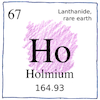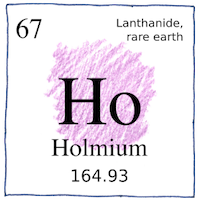Geneva, Uppsala—Marc Delafontaine,
Jacques-Louis Soret,
Per Teodor Cleve
elements

|
Holmium
Delafontaine and Soret discovered its unique spectrographic absorption bands. They called it “Element X.” Cleve isolated from erbia oxides for it and thulium and named it after Holmia (Latin for Stockholm), where he had been born.
Atomic number 67
Holmium has the strongest magnetic field than any metal including iron and nickel. Holmium lasers are used in medicine and dentistry. Holmium provides a yellow or red color for jewellery, glass, and optical calibration. Holmium chloride is yellow in natural light but turns bright pink in fluorescent light.
Mineral species
Many known mineral species contain small percentages of holmium. We would like to form a committee to name yet undiscovered species. Hiddeninite would have the least percentage and noplacelikite would have the most. Hathookite and cantgobackite would never be found in the same rocks. Condoite and apartmentite would fiercely compete for your holmium buyer.



We are not finished describing diminishing fractions of rare earths, but at least there are only a finite number of them.
Erbia (Jean Charles Galissard de Marignac’s oxide of erbium, which he had separated, along with yttria and terbia from Carl Gustav Mosander’s yttria) was eventually found to have contained erbium, thulium, holmium, dysprosium, scandium, ytterbium, and lutetium.
See also in The book of science:
Readings in wikipedia:
Other readings: